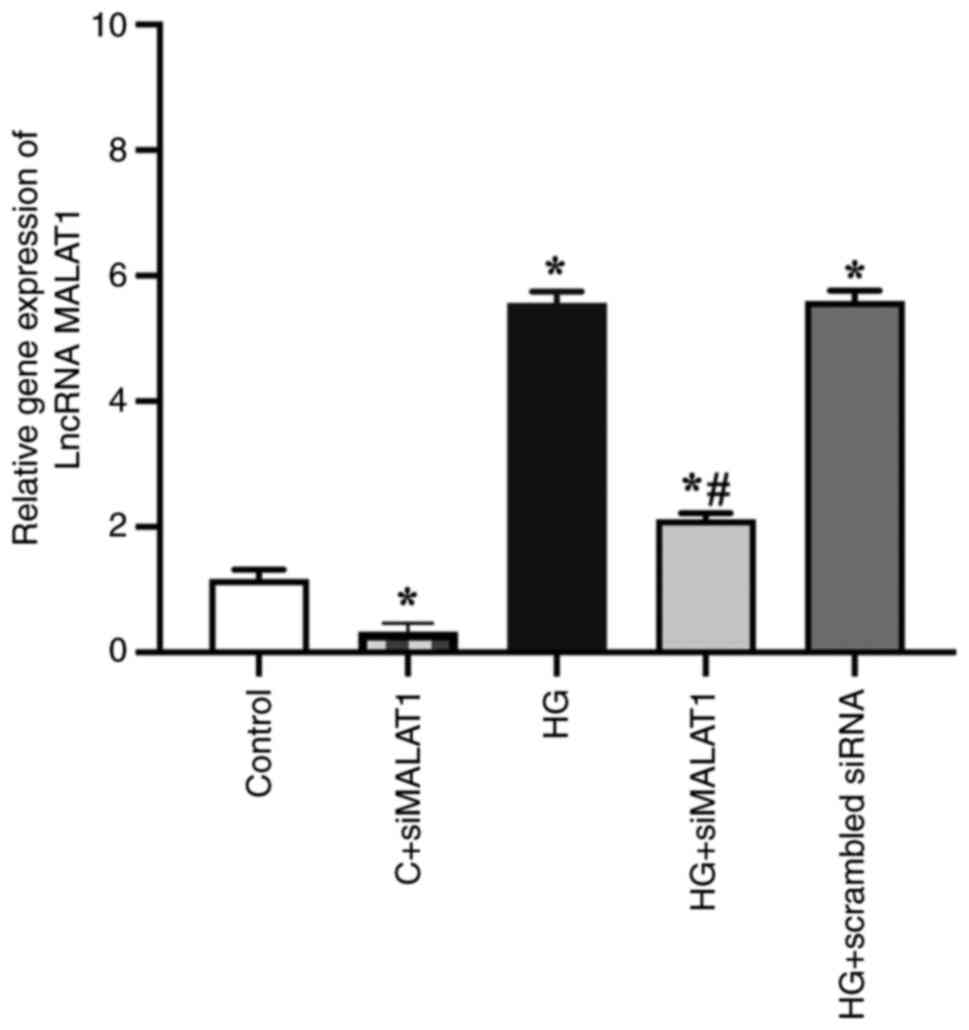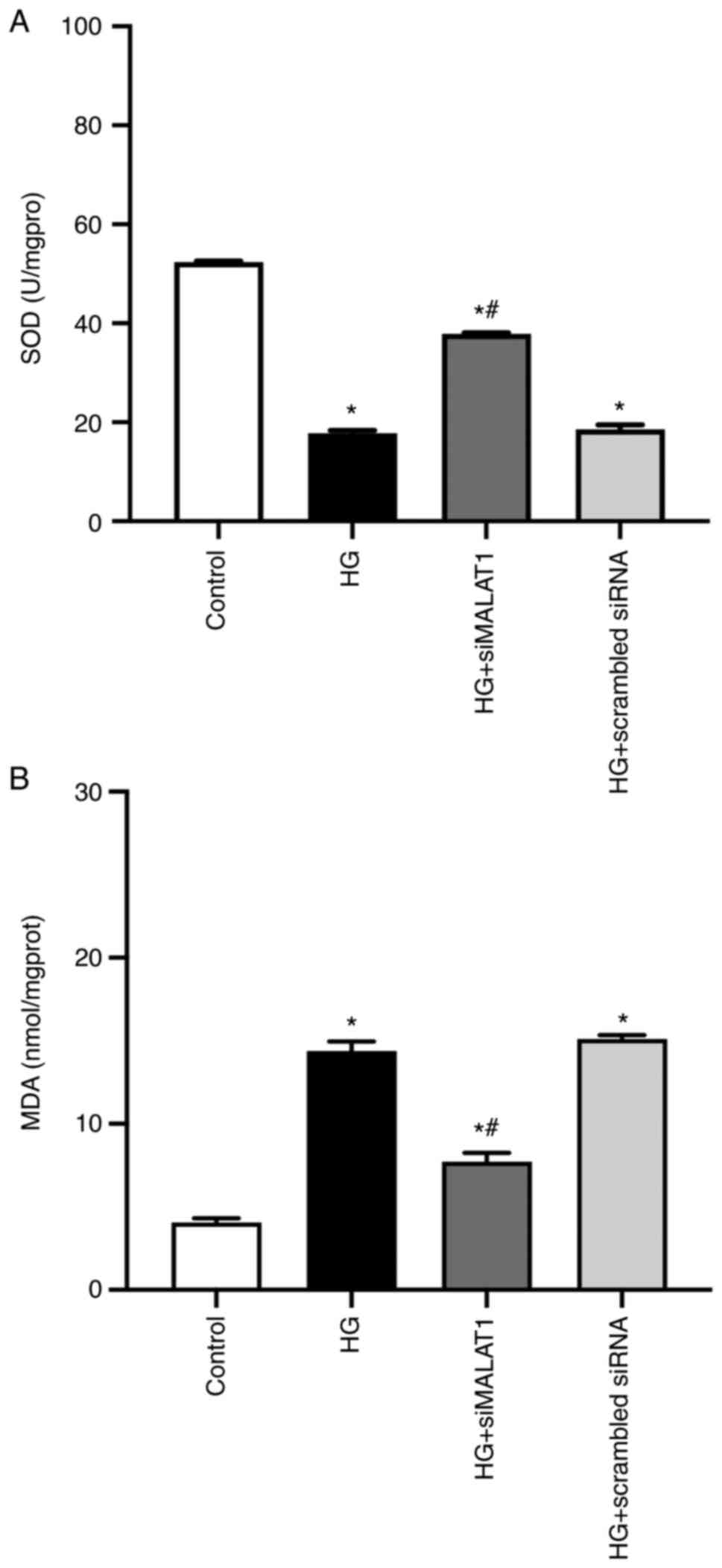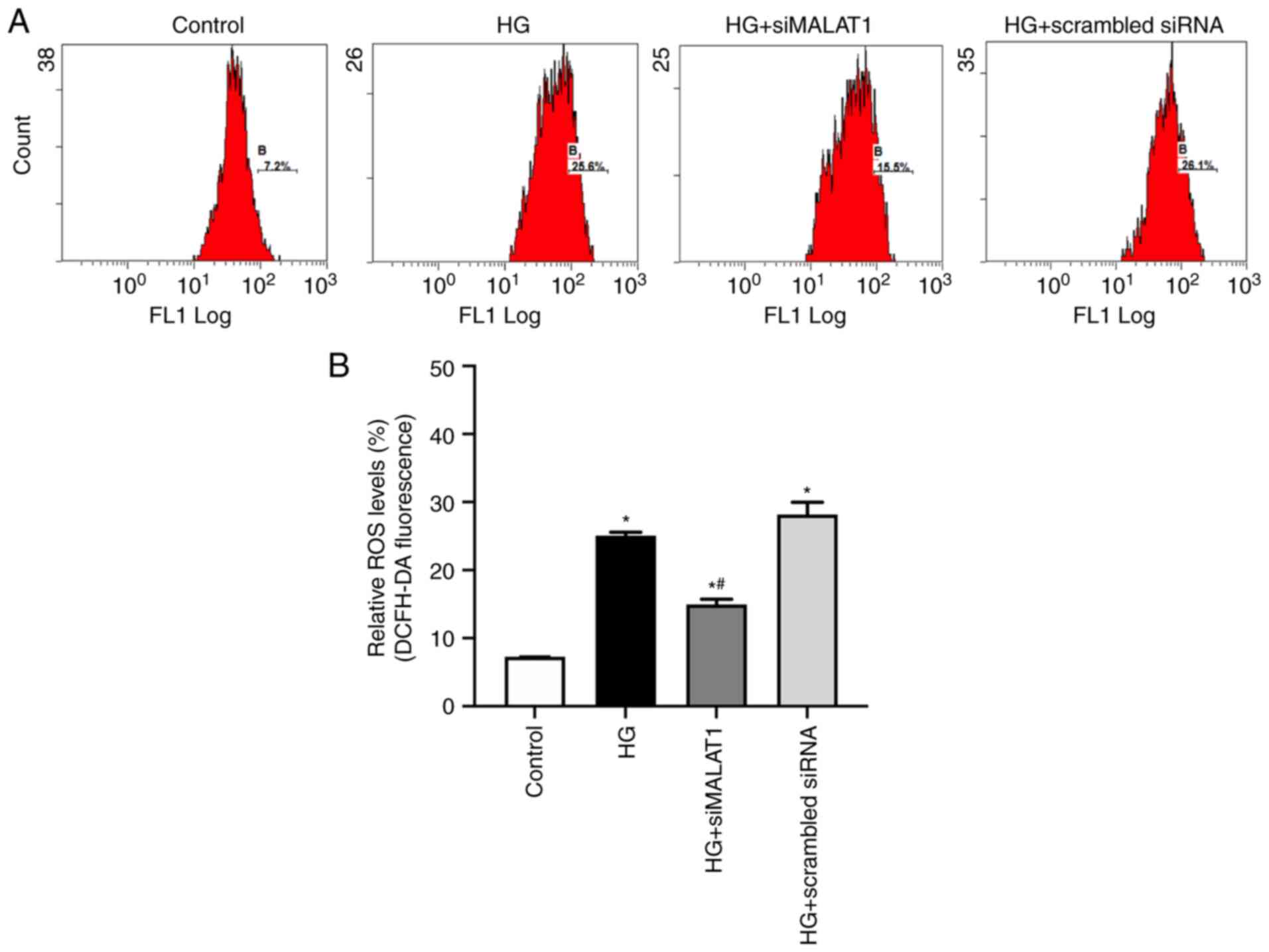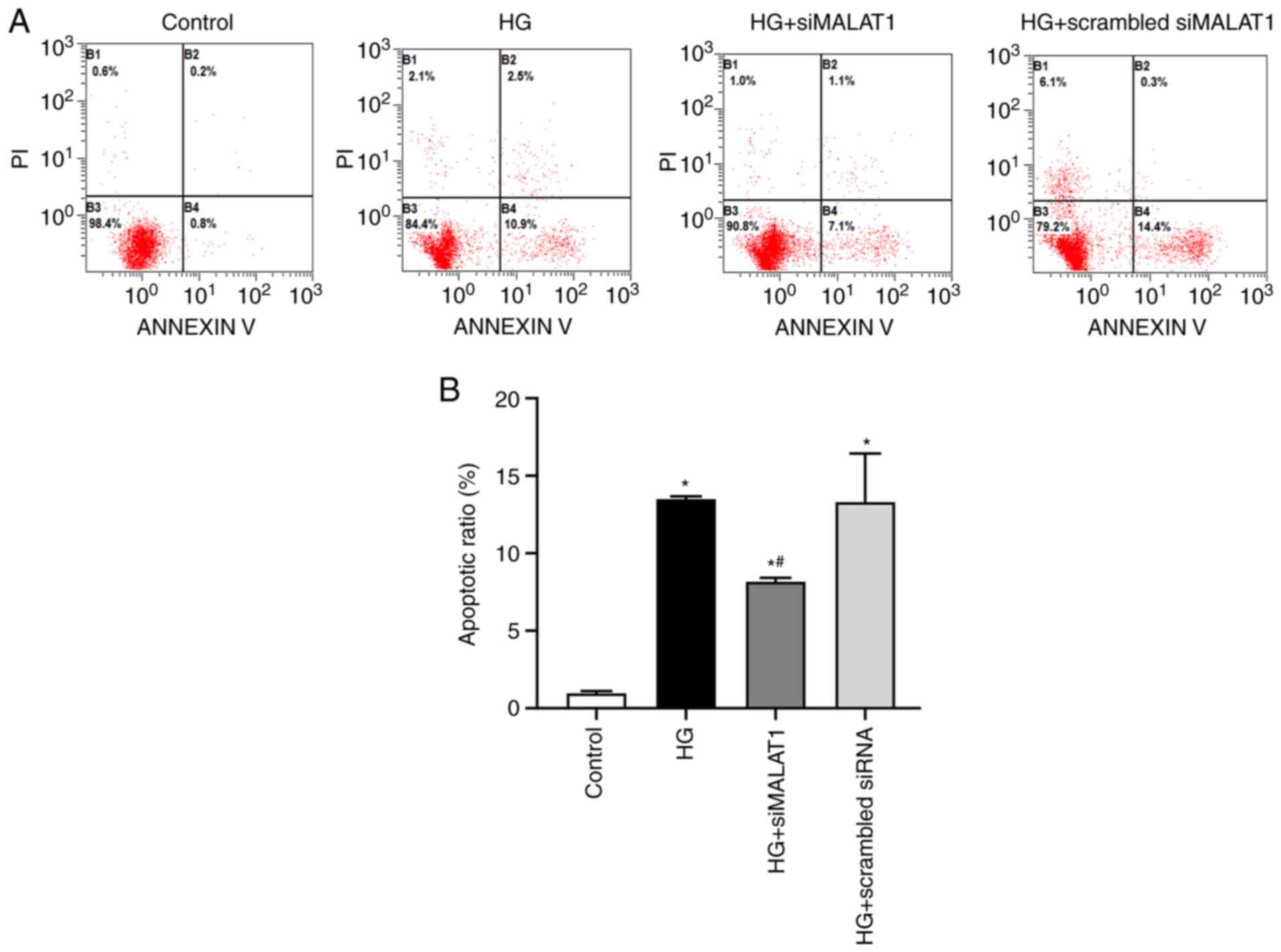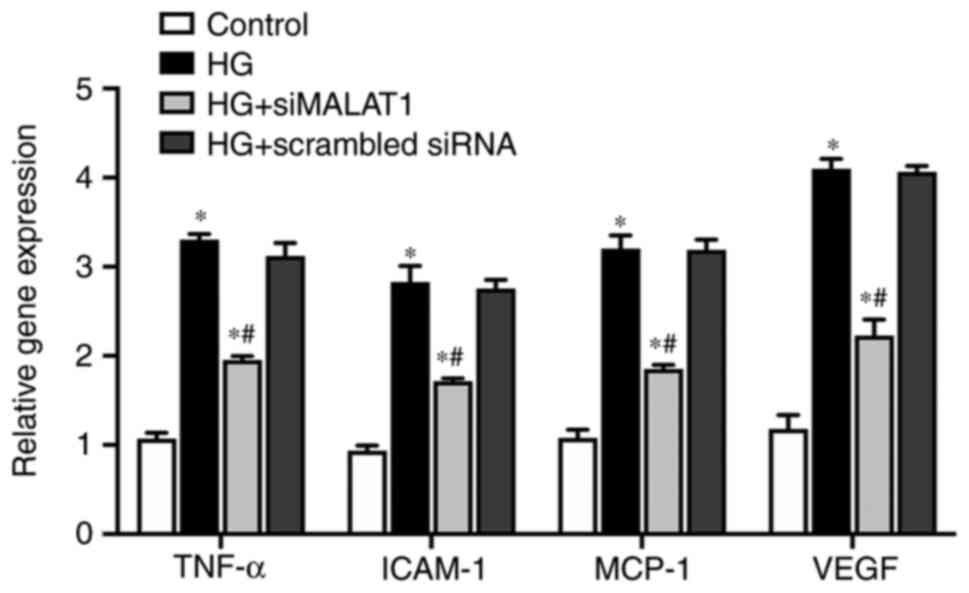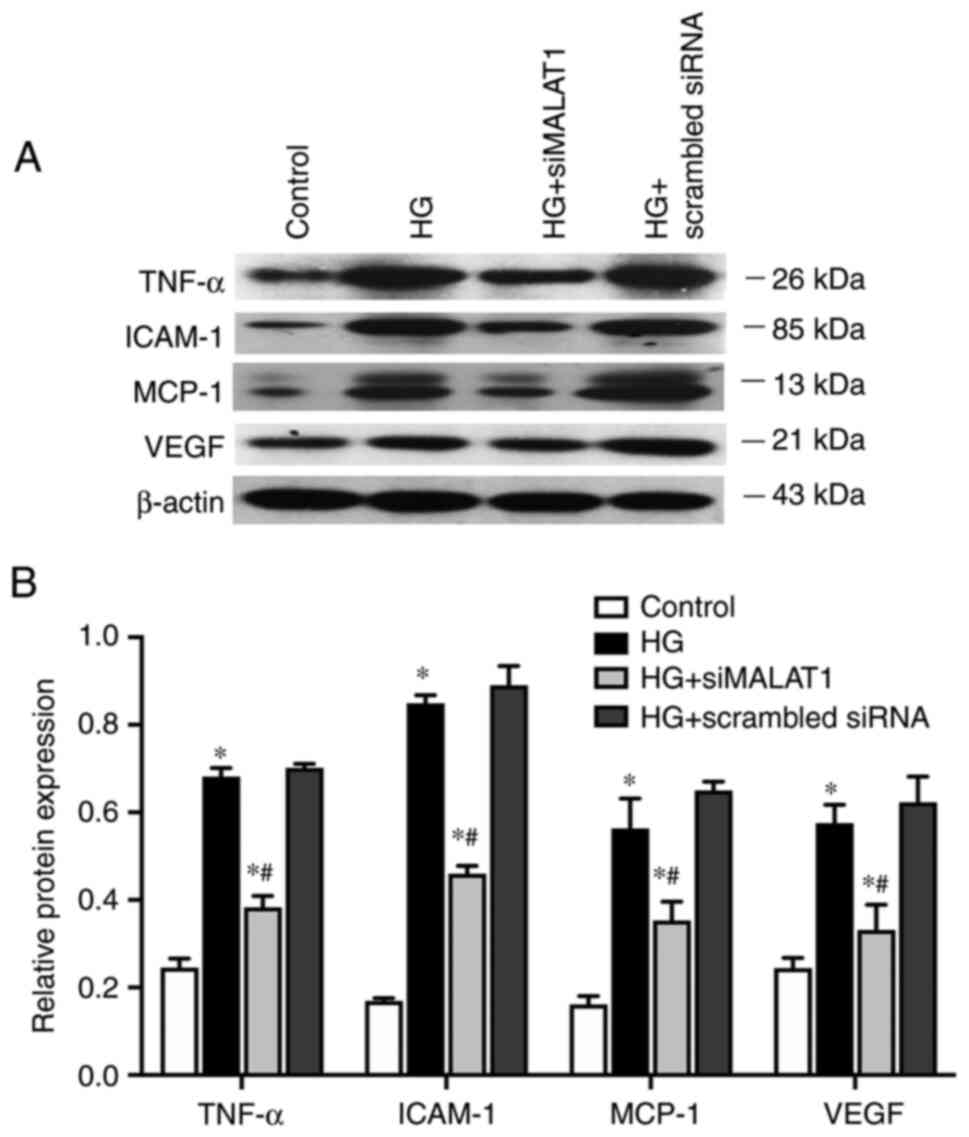Long non‑coding RNA MALAT1 is involved in retinal pigment epithelial cell damage caused by high glucose treatment
- Authors:
- Published online on: March 21, 2022 https://doi.org/10.3892/mmr.2022.12693
- Article Number: 177
Abstract
Introduction
Diabetic retinopathy (DR) is a severe microvascular complication of diabetes and is also the main cause of blindness in the adult population. Due to the increasing incidence of diabetes, the number of patients suffering from DR is continuously increasing (1). Blindness caused by DR may lead to a reduced quality of life and increased medical burden on both patients and society (2,3). Special gene targeting therapy strategies have been investigated in previous years (4).
The retinal pigment epithelial (RPE) cells form the outer blood retinal barrier (BRB). In diabetic animal models, increased leakage from the outer BRB (5) and disruptions of the RPE layer have been observed (6), indicating that RPE damage is involved in the pathogenesis of DR (7,8). Accumulating data have indicated that oxidative stress (8,9) inflammation (10) and apoptosis (11,12) are all involved in RPE damage caused by high glucose (HG) treatment, contributing to the breakdown of the BRB and RPE dysfunction observed in DR.
Long non-coding RNAs (lncRNAs) can be expressed in RPE cells under certain stimuli (13,14) and participate in RPE cell damage in DR (12). lncRNA metastasis-associated lung adenocarcinoma transcript 1 (lncRNA MALAT1) is a highly conserved lncRNA originally found in tumors (15). Studies conducted in previous years have demonstrated that increased MALAT1 expression may be involved in the development of DR (16,17), and participates in promoting inflammation (18), apoptosis and oxidative stress (19,20) in other cell types. However, systematic evaluation of the effect of MALAT1 on RPE cells has rarely been performed.
Therefore, the present study aimed to determine the effect of MALAT1 on human RPE cells in a HG environment and to explore the role of MALAT1 in DR.
Materials and methods
Cell culture and small interfering RNA (siRNA)-mediated interference
ARPE-19 cells, which were derived from human retinal pigment epithelium, were commercially obtained from Procell Life Science & Technology Co., Ltd. (cat. no. CL-0026) and maintained in six-well plates containing DMEM/F12 (cat. no. SH30022.01; HyClone; Cytiva) with 100 U/ml penicillin plus 100 µg/ml streptomycin (cat. no. 0503; Sciencell) and 10% fetal bovine serum (Every Green, cat. no. 11011-8611; Tianhang Biotech, Hangzhou) in a tissue-culturing bioincubator with 95% O2 and 5% CO2 at 37°C. Cells were passaged approximately once or twice every week.
siRNA targeting MALAT1 (si-MALAT1) and scrambled siRNA (si-Scrambled) were purchased from Sangon Biotech Co., Ltd. ARPE-19 cells were transfected using Lipofectamine® 2000 Reagent (cat. no. 11668-019; Invitrogen; Thermo Fisher Scientific, Inc.) for 4 h at a final siRNA concentration of 200 nmol/l in a tissue-culturing bio-incubator with 95% O2 and 5% CO2 at 37°C. At 4 h after transfection, the transfected cells were incubated with HG (25 mM D-glucose; cat. no. G8270; Millipore Sigma) at 37°C for 48 h (21) after the medium was replaced with fresh culture medium. ARPE-19 cells exposed to normal glucose were set as controls (control; 5.5 mM D-glucose; cat. no. G8270; Millipore Sigma). The oligonucleotides used were as follows: siMALAT1 sense, 5′-AGGUAAAGCUUGAGAAGAUTT-3′ and antisense, 5′-AUCUUCUCAAGCUUUACCUTT-3′; and control siScrambled sense, 5′-UUCUCCGAACGUGUCACGUTT-3′ and antisense, 5′-ACGUGACACGUUCGGAGAATT-3′ (22). Cells were harvested and subjected to further measurements.
Cell apoptosis assay
In order to evaluate whether MALAT1 can cause cell apoptosis, flow cytometry was used to assess the early + late apoptosis ratio. ARPE-19 cells were collected, and cell suspensions were prepared. Subsequently, 100 µl cell suspension (1×105 cells) was added to a tube. Cells were stained at room temperature with 5 µl Annexin V-FITC and then 5 µl PI (Annexin V-FITC/PI Apoptosis Detection kit; cat. no. CA1020; Beijing Solarbio Science & Technology Co., Ltd.), and incubated at room temperature in dark for 10 min and 5 min separately, and apoptotic cells were separated and analyzed via flow cytometry by its equipped Mfa32 software (Cytomics FC500 flow cytometer; both Beckman Coulter, Inc.).
Oxidative stress detection
Since HG may promote oxidative stress in cells, cellular reactive oxygen species (ROS) were detected using a Reactive Oxygen Species Assay kit (cat. no. E004; Nanjing Jiancheng Bioengineering Institute) according to the manufacturer's protocol. Briefly, cells were harvested and adjusted to 1×106 cells/ml. The cells were resuspended in 0.5 ml diluted dichloro-dihydro-fluorescein diacetate (DCFH-DA) and mixed well. Analysis was carried out on a flow cytometer immediately after incubation for 20 min at 37°C. ROS in cells were identified by flow cytometry (Cytomics FC500; Beckman Coulter, Inc.) in the FITC channel and data was analyzed by its equipped Mfa32 software.
Superoxide dismutase (SOD) and malondialdehyde (MDA) measurement
Cellular MDA content and SOD activity were detected using an MDA Assay kit (cat. no. A003-1) and a SOD Assay kit (cat. no. A001-1; both from Nanjing Jiancheng Bioengineering Institute), respectively, according to the manufacturer's protocols.
RNA isolation and PCR
Total RNA was extracted from cultured cells using TRIzol® reagent (cat. no. 15596026; Invitrogen; Thermo Fisher Scientific, Inc.). RNA quality and concentration were assessed by UV spectroscopy at 260 and 280 nm.
cDNA was synthesized using a HiFiScript gDNA Removal cDNA Synthesis kit (cat. no. CW2582S; CoWin Biosciences) according to the manufacturer's protocol. In brief, the RT reaction mixture was incubated at 42°C for 15 min, then incubated at 85°C for 5 min. Primers (Table I) were designed and synthesized by Sangon Biotech Co., Ltd. Quantitative PCR was performed using MonAmp™ SYBR Green qPCR Mix (cat. no. RN04005M; Monad Biotech Co., Ltd.) according to standard thermocycler conditions. Relative gene expression at the mRNA level was calculated from Cq values using the 2−ΔΔCq method (23). The thermocycling conditions were as follows: 95°C for 5 min; 40 cycles at 95°C for 10 sec, 58°C for 30 sec and 72°C for 30 sec. The expression of each gene was normalized to that of β-actin.
Protein isolation and western blotting
Total protein was extracted from cultured cells using RIPA cell lysis buffer (cat. no. R0020; Beijing Solarbio Science & Technology Co., Ltd.). Protein concentrations were measured by spectrophotometer using absorbance at 280 nm (model 22331; Eppendorf AG). Total protein (40 µg/lane) was electrophoresed on 10% SDS-polyacrylamide gels and transferred onto PVDF membranes (cat. no. IPVH00010; Millipore; Merck KGaA) by electroblotting. The PVDF membranes were blocked for 1 h in 5% nonfat milk at room temperature before incubation with primary antibodies, including rabbit anti-TNF-α (cat. no. bs-0078R; poly-antibody; rabbit-anti-human; 1:600; BIOSS), monocyte chemotactic protein 1 (MCP-1; cat. no. PAA087HU01; poly-antibody; rabbit-anti-human; 1:1,000; Wuhan USCN Business Co., Ltd.), intercellular cell adhesion molecule 1 (ICAM-1; cat. no. bs-4615R; poly-antibody; rabbit-anti-human; 1:800; BIOSS), vascular endothelial growth factor (VEGF; cat. no. bs-0279R; poly-antibody; rabbit-anti-human; 1:600; BIOSS) and anti-β-actin antibodies (cat. no. TA-09; poly-antibody; mouse-anti-human; 1:1,000; OriGene Technologies, Inc.) overnight at 4°C. The membranes were further incubated with anti-rabbit IgG-HRP secondary antibody (cat. no. ZB2301; poly-antibody; goat-anti-rabbit; 1:3,000; OriGene Technologies, Inc.) at room temperature for 1 h. The blots were developed using ECL (cat. no. sc-2048; Santa Cruz Biotechnology, Inc.). Tanon Gis software (ver. 4.00; Tanon Science and Technology Co., Ltd.) was used for semi-quantification of protein expression and data were normalized to that of β-actin.
Statistical analysis
Experiments were repeated 3 times. Data are presented as the mean ± standard deviation. Statistical analyses among groups were performed by one-way analysis of variance followed by Tukey's multiple comparison test. P<0.05 was considered to indicate a statistically significant difference. Analyses were performed using GraphPad Prism 9.0.0 for MacOS (GraphPad Software, Inc.).
Results
HG increases MALAT1 expression in ARPE-19 cells
The results revealed that the expression of MALAT1 was successfully knocked down by siMALAT1 transfection. Significantly increased MALAT1 gene expression was found in the HG-treated ARPE-19 cells compared with the control cells (Fig. 1; P<0.05), indicating that HG treatment increased MALAT1 expression in ARPE-19 cells. This expression was strongly impaired by siMALAT1 transfection (Fig. 1; P<0.05).
lncRNA MALAT1 knockdown decreases HG-induced oxidative stress in ARPE-19 cells
Increased cellular MDA levels and decreased SOD activity may lead to increased ROS production (24). In the present study, compared with the control, HG treatment led to significantly increased MDA content and reduced SOD activity (Fig. 2A and B; both P<0.05) and significantly increased ROS levels in ARPE-19 cells (Fig. 3A and B; P<0.05), indicating that HG treatment led to increased ARPE-19 cellular oxidative stress by elevating MDA content while inhibiting SOD activities. All these effects achieved by HG could be partly reversed by MALAT1 knockdown (Fig. 2A and B; both P<0.05), which resulted in reduced ROS levels (Fig. 3A and B; P<0.05), indicating that increased MALAT1 may be involved in the increased retinal endothelial oxidative stress caused by HG. Inhibiting MALAT1 may alleviate ROS overload by rebalancing the cellular effects of MDA and SOD.
MALAT1 knockdown reduces ARPE-19 cell apoptosis induced by HG treatment
In the present study, HG treatment was associated with significantly increased apoptosis of ARPE-19 cells compared with that of cells under normal glucose conditions (Fig. 4A and B; P<0.05) indicating that HG treatment may cause ARPE-19 cell damage partly by increasing apoptosis, and this effect could be substantially inhibited by MALAT1 knockdown (Fig. 4A and B; P<0.05). Therefore, elevated MALAT1 expression may be involved in HG-induced ARPE-19 cell apoptosis.
MALAT1 knockdown attenuates inflammation induced by HG
In the present study, compared with those in the control cells, the expression levels of genes involved in inflammation of ARPE-19 cells, including the inflammatory cytokine TNF-α, the endothelial adhesion molecule ICAM-1 and the immunogenic cytokine MCP-1, were significantly increased under HG treatment at both the mRNA (Fig. 5; all P<0.05) and protein levels (Fig. 6A and B; all P<0.05).
VEGF, which is considered both an inflammatory and angiogenic factor, was also upregulated by HG treatment at both the mRNA (Fig. 5; P<0.05) and protein levels (Fig. 6A and B; P<0.05). The expression levels of all the genes elevated by HG were largely impaired by MALAT1 knockdown (all P<0.05; Figs. 5 and 6). Therefore, HG treatment may promote the ARPE-19 cellular inflammatory response by upregulating the expression levels of inflammation-related genes, which may partly be due to activating MALAT1 expression. Increased MALAT1 expression may be detrimental in APRE-19 cells by promoting the downstream inflammatory response.
Discussion
In recent years, an increasing number of studies have indicated that structural and functional disorders in the RPE are involved in the pathogenesis of DR (14,21,25), and that numerous lncRNAs are involved in this process (12,26–28). lncRNA MALAT1, which was first identified in lung carcinoma cells (29), performs multiple functions as a stress response gene that can be differently expressed under some stress, such as HG (30). MALAT1 has been found to be closely associated with a number of diabetic complications (31). MALAT1 expression has been reported to be increased in the retinas of diabetic animal models (32,33) and in endothelial cells of the retina under HG treatment, which may contribute to the occurrence of DR (16,17,34). It has also been suggested that MALAT1 can be expressed in RPE cells (35) and elevated MALAT1 expression in RPE cells is considered to be involved in the pathogenesis of proliferative retinal disease (36,37).
The present study revealed that HG may stimulate MALAT1 expression in ARPE-19 cells. However, at present, the mechanisms underlying HG stimulation of MALAT1 in RPE cells remain largely unknown. Gong et al (19) demonstrated that HG may upregulate MALAT1 expression via SP1 binding to MALAT1 promoter regions in human lens epithelial cells. Whether similar mechanisms also exist in RPE cells still needs to be further explored.
Oxidative stress is a key contributor to the pathogenesis of DR (38). Data from the present study demonstrated that MALAT1 was involved in HG-induced oxidative stress in ARPE-19 cells by increasing MDA levels while reducing antioxidant SOD activity. It has been previously reported that increased expression of genes, including microRNA-34a (9) and NLR family pyrin domain containing 3 (39), and impairment of the nuclear factor-erythroid factor 2-related factor 2 signaling pathway (21) in RPE cells are all involved in oxidative stress caused by HG, and these genes have been demonstrated to be the downstream target genes of MALAT1 in other cells types (17,40,41).
HG treatment may induce RPE cell apoptosis, which has been illustrated previously (42,43). However, the concentration of HG mentioned in those studies varied from 25 mM (21,42) to 50 mM (43). In the present study, ARPE-19 cell apoptosis could be induced at 25 mM glucose, which was consistent with previous studies. MALAT1 has been found to be involved in HG-induced apoptosis in cartilage endplate cells and lens epithelial cells by targeting the p38 MAPK signaling pathway (19,20), while the p38 MAPK signaling pathway has been found to participate in HG-induced RPE cell apoptosis (42). Therefore, MALAT1 may be a pivotal mediator in HG-induced RPE cell apoptosis.
MALAT1 has been found to be a pro-inflammatory factor and may regulate glucose-induced inflammatory action in cells (34,44). In the present study, MALAT1 knockdown could substantially blunt the effect of HG on the expression of genes involved in inflammation, indicating that MALAT1 may be involved in the inflammatory response in RPE cells caused by HG. Similar results in RPE cells have rarely been reported previously. MALAT1 may target some inflammatory pathways, such as the NF-κB signaling pathway (45), which is an important mediator in the inflammatory response in RPE cells (46,47).
The RPE may express and secret VEGF (48), and this procedure can be stimulated by HG (49), hypoxia (50) and oxidative stress (51). In the present study, increased VEGF gene expression induced by HG was also impaired by MALAT1 knockdown. MALAT1 may elevate VEGF expression in RPE cells directly (52) or indirectly by increasing oxidative stress.
There are still some limitations in the present study. First, the number of dead cells were found to be unexpectedly higher in the HG group and could also be alleviated by MALAT1 knockdown, thus, there may be certain mechanisms underlying MALAT1 modulating cell death which were not originally designed in the present study. Second, since this is a preliminary study concerning the role of MALAT1 in ARPE-19 cells, detailed signaling pathways and relative intervention studies were insufficient.
In conclusion, MALAT1 was involved in ARPE-19 cell damage caused by HG by prompting oxidative stress, the inflammatory response and apoptosis. Targeting MALAT1 may be a promising therapeutic strategy for DR treatment. However, detailed mechanisms underlying the effects of MALAT1 on RPE cells still need to be further explored in both in vitro and in vivo studies.
Acknowledgements
The authors would like to thank Professor Huijie Ma (Department of Physiology, Hebei Medical University, Shijiazhuang, China) for technical help and discussion of the results obtained in the experiments.
Funding
The present study was supported by Projects of the Medical Science Research of Health Commission of Hebei Province, China (grant nos. 20210725 and 20210513). The funders had no role in the study design, data collection and analysis, decision to publish or preparation of the manuscript.
Availability of data and materials
The datasets used and/or analyzed during the current study are available from the corresponding author on reasonable request.
Authors' contributions
JM and YL conceived and designed the study. XJ, YW and PZ performed the experiments, and wrote, reviewed and revised the manuscript. YZ, HM, XJ and YL were involved in the analysis and interpretation of data, and performed the statistical analysis. XJ and YL confirm the authenticity of all the raw data. All authors read and approved the final manuscript.
Ethics approval and consent to participate
Not applicable.
Patient consent for publication
Not applicable.
Competing interests
The authors declare that they have no competing interests.
Glossary
Abbreviations
Abbreviations:
|
DR |
diabetic retinopathy |
|
SOD |
superoxide dismutase |
|
MDA |
malondialdehyde |
|
ROS |
reactive oxygen species |
|
MCP-1 |
monocyte chemotactic protein 1 |
|
ICAM-1 |
intercellular cell adhesion molecule 1 |
|
VEGF |
vascular endothelial growth factor |
|
lncRNA MALAT1 |
long non-coding RNA metastasis associated lung adenocarcinoma transcript 1 |
References
|
Wong TY, Cheung CM, Larsen M, Sharma S and Simó R: Diabetic retinopathy. Nat Rev Dis Primers. 2:160122016. View Article : Google Scholar : PubMed/NCBI | |
|
Saaddine JB, Honeycutt AA, Narayan KM, Zhang X, Klein R and Boyle JP: Projection of diabetic retinopathy and other major eye diseases among people with diabetes mellitus: United States, 2005-2050. Arch Ophthalmol. 126:1740–1747. 2008. View Article : Google Scholar : PubMed/NCBI | |
|
Mazhar K, Varma R, Choudhury F, McKean-Cowdin R, Shtir CJ and Azen SP; Los Angeles Latino Eye Study Group, : Severity of diabetic retinopathy and health-related quality of life: The Los Angeles latino eye study. Ophthalmology. 118:649–655. 2011. View Article : Google Scholar : PubMed/NCBI | |
|
Amadio M, Pascale A, Cupri S, Pignatello R, Osera C, D'Agata V, D'Amico AG, Leggio GM, Ruozi B, Govoni S, et al: Nanosystems based on siRNA silencing HuR expression counteract diabetic retinopathy in rat. Pharmacol Res. 111:713–720. 2016. View Article : Google Scholar : PubMed/NCBI | |
|
Xu HZ and Le YZ: Significance of outer blood-retina barrier breakdown in diabetes and ischemia. Invest Ophthalmol Vis Sci. 52:2160–2164. 2011. View Article : Google Scholar : PubMed/NCBI | |
|
Tarchick MJ, Bassiri P, Rohwer RM and Samuels IS: Early functional and morphologic abnormalities in the diabetic nyxnob mouse retina. Invest Ophthalmol Vis Sci. 57:3496–3508. 2016. View Article : Google Scholar : PubMed/NCBI | |
|
Simó R, Villarroel M, Corraliza L, Hernández C and Garcia-Ramírez M: The retinal pigment epithelium: Something more than a constituent of the blood-retinal barrier-implications for the pathogenesis of diabetic retinopathy. J Biomed Biotechnol. 2010:1907242010. View Article : Google Scholar : PubMed/NCBI | |
|
Li H, Li R, Wang L, Liao D, Zhang W and Wang J: Proanthocyanidins attenuate the high glucose-induced damage of retinal pigment epithelial cells by attenuating oxidative stress and inhibiting activation of the NLRP3 inflammasome. J Biochem Mol Toxicol. 35:e228452021. View Article : Google Scholar : PubMed/NCBI | |
|
Li W and Xiao H: Dihydromyricetin alleviates high glucose-induced oxidative stress and apoptosis in human retinal pigment epithelial cells by downregulating miR-34a expression. Diabetes Metab Syndr Obes. 14:387–397. 2021. View Article : Google Scholar : PubMed/NCBI | |
|
Xiao H and Liu Z: Effects of microRNA-217 on high glucose-induced inflammation and apoptosis of human retinal pigment epithelial cells (ARPE-19) and its underlying mechanism. Mol Med Rep. 20:5125–5133. 2019.PubMed/NCBI | |
|
Kim DI, Park MJ, Lim SK, Choi JH, Kim JC, Han HJ, Kundu TK, Park JI, Yoon KC, Park SW, et al: High-glucose-induced CARM1 expression regulates apoptosis of human retinal pigment epithelial cells via histone 3 arginine 17 dimethylation: Role in diabetic retinopathy. Arch Biochem Biophys. 560:36–43. 2014. View Article : Google Scholar : PubMed/NCBI | |
|
Yin L, Sun Z, Ren Q, Su X and Zhang D: Long non-coding RNA BANCR is overexpressed in patients with diabetic retinopathy and promotes apoptosis of retinal pigment epithelial cells. Med Sci Monit. 25:2845–2851. 2019. View Article : Google Scholar : PubMed/NCBI | |
|
Kutty RK, Samuel W, Duncan T, Postnikova O, Jaworski C, Nagineni CN and Redmond TM: Proinflammatory cytokine interferon-γ increases the expression of BANCR, a long non-coding RNA, in retinal pigment epithelial cells. Cytokine. 104:147–150. 2018. View Article : Google Scholar : PubMed/NCBI | |
|
Yang J, Yang K, Meng X, Liu P, Fu Y and Wang Y: Silenced SNHG1 inhibited epithelial-mesenchymal transition and inflammatory response of ARPE-19 cells induced by high glucose. J Inflamm Res. 14:1563–1573. 2021. View Article : Google Scholar : PubMed/NCBI | |
|
Zhang X, Hamblin MH and Yin KJ: The long noncoding RNA Malat1: Its physiological and pathophysiological functions. RNA Biol. 14:1705–1714. 2017. View Article : Google Scholar : PubMed/NCBI | |
|
Biswas S, Thomas AA, Chen S, Aref-Eshghi E, Feng B, Gonder J, Sadikovic B and Chakrabarti S: MALAT1: An epigenetic regulator of inflammation in diabetic retinopathy. Sci Rep. 8:65262018. View Article : Google Scholar : PubMed/NCBI | |
|
Radhakrishnan R and Kowluru RA: Long noncoding RNA MALAT1 and regulation of the antioxidant defense system in diabetic retinopathy. Diabetes. 70:227–239. 2021. View Article : Google Scholar : PubMed/NCBI | |
|
Huang K, Yu X, Yu Y, Zhang L, Cen Y and Chu J: Long noncoding RNA MALAT1 promotes high glucose-induced inflammation and apoptosis of vascular endothelial cells by regulating miR-361-3p/SOCS3 axis. Int J Clin Exp Pathol. 13:1243–1252. 2020.PubMed/NCBI | |
|
Gong W, Zhu G, Li J and Yang X: LncRNA MALAT1 promotes the apoptosis and oxidative stress of human lens epithelial cells via p38MAPK pathway in diabetic cataract. Diabetes Res Clin Pract. 144:314–321. 2018. View Article : Google Scholar : PubMed/NCBI | |
|
Jiang Z, Zeng Q, Li D, Ding L, Lu W, Bian M and Wu J: Long non-coding RNA MALAT1 promotes high glucose-induced rat cartilage endplate cell apoptosis via the p38/MAPK signalling pathway. Mol Med Rep. 21:2220–2226. 2020.PubMed/NCBI | |
|
Zhao X, Wang J, Li P, Tang L and Bai Y: Casein kinase 2-interacting protein-1 alleviates high glucose-reduced autophagy, oxidative stress, and apoptosis in retinal pigment epithelial cells via activating the p62/KEAP1/NRF2 signaling pathway. J Ophthalmol. 2021:66940502021. View Article : Google Scholar : PubMed/NCBI | |
|
Li T, Niu L, Li M, Liu Y, Xu Z, Gao X and Liu D: Effects of small interfering RNA-mediated downregulation of the Krüppel-like factor 4 gene on collagen metabolism in human hepatic stellate cells. Mol Med Rep. 12:3972–3978. 2015. View Article : Google Scholar : PubMed/NCBI | |
|
Livak KJ and Schmittgen TD: Analysis of relative gene expression data using real-time quantitative PCR and the 2(−Delta Delta C(T)) method. Methods. 25:402–408. 2001. View Article : Google Scholar : PubMed/NCBI | |
|
Ho E, Karimi Galougahi K, Liu CC, Bhindi R and Figtree GA: Biological markers of oxidative stress: Applications to cardiovascular research and practice. Redox Biol. 1:483–491. 2013. View Article : Google Scholar : PubMed/NCBI | |
|
Fu SH, Lai MC, Zheng YY, Sun YW, Qiu JJ, Gui F, Zhang Q and Liu F: MiR-195 inhibits the ubiquitination and degradation of YY1 by Smurf2, and induces EMT and cell permeability of retinal pigment epithelial cells. Cell Death Dis. 12:7082021. View Article : Google Scholar : PubMed/NCBI | |
|
Tong P, Peng QH, Gu LM, Xie WW and Li WJ: LncRNA-MEG3 alleviates high glucose induced inflammation and apoptosis of retina epithelial cells via regulating miR-34a/SIRT1 axis. Exp Mol Pathol. 107:102–109. 2019. View Article : Google Scholar : PubMed/NCBI | |
|
Dong Y, Wan G, Peng G, Yan P, Qian C and Li F: Long non-coding RNA XIST regulates hyperglycemia-associated apoptosis and migration in human retinal pigment epithelial cells. Biomed Pharmacother. 125:1099592020. View Article : Google Scholar : PubMed/NCBI | |
|
Yu X, Luo Y, Chen G, Liu H, Tian N, Zen X and Liu Q: Long noncoding RNA IGF2AS regulates high-glucose induced apoptosis in human retinal pigment epithelial cells. IUBMB Life. 71:1611–1618. 2019. View Article : Google Scholar : PubMed/NCBI | |
|
Ji P, Diederichs S, Wang W, Böing S, Metzger R, Schneider PM, Tidow N, Brandt B, Buerger H, Bulk E, et al: MALAT-1, a novel noncoding RNA, and thymosin beta4 predict metastasis and survival in early-stage non-small cell lung cancer. Oncogene. 22:8031–8041. 2003. View Article : Google Scholar : PubMed/NCBI | |
|
Lei L, Chen J, Huang J, Lu J, Pei S, Ding S, Kang L, Xiao R and Zeng Q: Functions and regulatory mechanisms of metastasis-associated lung adenocarcinoma transcript 1. J Cell Physiol. 234:134–151. 2018. View Article : Google Scholar : PubMed/NCBI | |
|
Abdulle LE, Hao JL, Pant OP, Liu XF, Zhou DD, Gao Y, Suwal A and Lu CW: MALAT1 as a diagnostic and therapeutic target in diabetes-related complications: A promising long-noncoding RNA. Int J Med Sci. 16:548–555. 2019. View Article : Google Scholar : PubMed/NCBI | |
|
Yan B, Tao ZF, Li XM, Zhang H, Yao J and Jiang Q: Aberrant expression of long noncoding RNAs in early diabetic retinopathy. Invest Ophthalmol Vis Sci. 55:941–951. 2014. View Article : Google Scholar : PubMed/NCBI | |
|
Liu JY, Yao J, Li XM, Song YC, Wang XQ, Li YJ, Yan B and Jiang Q: Pathogenic role of lncRNA-MALAT1 in endothelial cell dysfunction in diabetes mellitus. Cell Death Dis. 5:e15062014. View Article : Google Scholar : PubMed/NCBI | |
|
Puthanveetil P, Chen S, Feng B, Gautam A and Chakrabarti S: Long non-coding RNA MALAT1 regulates hyperglycaemia induced inflammatory process in the endothelial cells. J Cell Mol Med. 19:1418–1425. 2015. View Article : Google Scholar : PubMed/NCBI | |
|
Postnikova OA, Rogozin IB, Samuel W, Nudelman G, Babenko VN, Poliakov E and Redmond TM: Volatile evolution of long non-coding RNA repertoire in retinal pigment epithelium: Insights from comparison of bovine and human RNA expression profiles. Genes (Basel). 10:2052019. View Article : Google Scholar : PubMed/NCBI | |
|
Zhou RM, Wang XQ, Yao J, Shen Y, Chen SN, Yang H, Jiang Q and Yan B: Identification and characterization of proliferative retinopathy-related long noncoding RNAs. Biochem Biophys Res Commun. 465:324–330. 2015. View Article : Google Scholar : PubMed/NCBI | |
|
Yang S, Yao H, Li M, Li H and Wang F: Long non-coding RNA MALAT1 mediates transforming growth factor beta1-induced epithelial-mesenchymal transition of retinal pigment epithelial cells. PLoS One. 11:e01526872016. View Article : Google Scholar : PubMed/NCBI | |
|
Wu MY, Yiang GT, Lai TT and Li CJ: The oxidative stress and mitochondrial dysfunction during the pathogenesis of diabetic retinopathy. Oxid Med Cell Longev. 2018:34201872018. View Article : Google Scholar : PubMed/NCBI | |
|
Yang Q, Li S, Zhou Z, Fu M, Yang X, Hao K and Liu Y: HDAC6 inhibitor Cay10603 inhibits high glucose-induced oxidative stress, inflammation and apoptosis in retinal pigment epithelial cells via regulating NF-κB and NLRP3 inflammasome pathway. Gen Physiol Biophys. 39:169–177. 2020. View Article : Google Scholar : PubMed/NCBI | |
|
Li F, Li X, Qiao L, Liu W, Xu C and Wang X: MALAT1 regulates miR-34a expression in melanoma cells. Cell Death Dis. 10:3892019. View Article : Google Scholar : PubMed/NCBI | |
|
Song Y, Yang L, Guo R, Lu N, Shi Y and Wang X: Long noncoding RNA MALAT1 promotes high glucose-induced human endothelial cells pyroptosis by affecting NLRP3 expression through competitively binding miR-22. Biochem Biophys Res Commun. 509:359–366. 2019. View Article : Google Scholar : PubMed/NCBI | |
|
Maugeri G, Bucolo C, Drago F, Rossi S, Di Rosa M, Imbesi R, D'Agata V and Giunta S: Attenuation of high glucose-induced damage in RPE cells through p38 MAPK signaling pathway inhibition. Front Pharmacol. 12:6846802021. View Article : Google Scholar : PubMed/NCBI | |
|
Zhang Y, Xi X, Mei Y, Zhao X, Zhou L, Ma M, Liu S, Zha X and Yang Y: High-glucose induces retinal pigment epithelium mitochondrial pathways of apoptosis and inhibits mitophagy by regulating ROS/PINK1/Parkin signal pathway. Biomed Pharmacother. 111:1315–1325. 2019. View Article : Google Scholar : PubMed/NCBI | |
|
Gordon AD, Biswas S, Feng B and Chakrabarti S: MALAT1: A regulator of inflammatory cytokines in diabetic complications. Endocrinol Diabetes Metab. 1:e000102018. View Article : Google Scholar : PubMed/NCBI | |
|
Gong YP, Zhang YW, Su XQ and Gao HB: Inhibition of long noncoding RNA MALAT1 suppresses high glucose-induced apoptosis and inflammation in human umbilical vein endothelial cells by suppressing the NF-κB signaling pathway. Biochem Cell Biol. 98:669–675. 2020. View Article : Google Scholar : PubMed/NCBI | |
|
Chen X, Han R, Hao P, Wang L, Liu M, Jin M, Kong D and Li X: Nepetin inhibits IL-1β induced inflammation via NF-κB and MAPKs signaling pathways in ARPE-19 cells. Biomed Pharmacother. 101:87–93. 2018. View Article : Google Scholar : PubMed/NCBI | |
|
Zhang J, Zhou K, Zhang X, Zhou Y, Li Z and Shang F: Celastrol ameliorates inflammation in human retinal pigment epithelial cells by suppressing NF-κB signaling. J Ocul Pharmacol Ther. 35:116–123. 2019. View Article : Google Scholar : PubMed/NCBI | |
|
Sant DW, Camarena V, Mustafi S, Li Y, Wilkes Z, Van Booven D, Wen R and Wang G: Ascorbate suppresses VEGF expression in retinal pigment epithelial cells. Invest Ophthalmol Vis Sci. 59:3608–3618. 2018. View Article : Google Scholar : PubMed/NCBI | |
|
Qin D and Jiang YR: Tangeretin inhibition of high-glucose-induced IL-1β, IL-6, TGF-β1, and VEGF expression in human RPE cells. J Diabetes Res. 2020:94906422020. View Article : Google Scholar : PubMed/NCBI | |
|
Hwang S, Seong H, Ryu J, Jeong JY, Kang TS, Nam KY, Seo SW, Kim SJ, Kang SS and Han YS: Phosphorylation of STAT3 and ERBB2 mediates hypoxia-induced VEGF release in ARPE-19 cells. Mol Med Rep. 22:2733–2740. 2020.PubMed/NCBI | |
|
Du W, An Y, He X, Zhang D and He W: Protection of kaempferol on oxidative stress-induced retinal pigment epithelial cell damage. Oxid Med Cell Longev. 2018:16107512018. View Article : Google Scholar : PubMed/NCBI | |
|
Yu L, Fu J, Yu N, Wu Y and Han N: Long noncoding RNA MALAT1 participates in the pathological angiogenesis of diabetic retinopathy in an oxygen-induced retinopathy mouse model by sponging miR-203a-3p. Can J Physiol Pharmacol. 98:219–227. 2020. View Article : Google Scholar : PubMed/NCBI |



